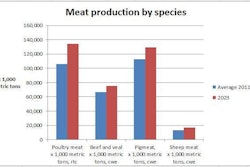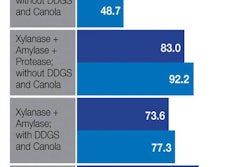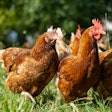Profitability, through the utilization and impact of nutrients, combined with animal health, are two of the most important challenges in today’s animal production. Kemin initiated two seminars with leading animal nutrition experts in Germany and Belgium to address these challenges and create a greater understanding of lipid nutrition.
“It is clearly understood that to maintain profits for swine and poultry production, the industry must increase the profitability of meat, while maintaining high animal health and meat quality standards,” said John Springate, president of the animal nutrition and health division of Kemin. “Oils and fats are an important energy contribution that can improve profits; however, their impact is often underestimated. Through discussions with leading researchers, Kemin hopes to raise awareness for the science and strategies behind lipid nutrition.”
The seminar’s first speaker, Julian Wiseman, professor at Nottingham University, said the biological composition and nutritional value of fats and oils varies and can greatly influence animal production. He explained that the degree of saturation, the content of free fatty acids, the chain length of constituent fatty acids and contaminants, are all factors that affect the energy value as well as the age of the animal. The Wiseman equation brings these numerous parameters together into one general equation to accurately estimate the apparent metabolizable energy (AME) of the fat. Wiseman highlighted that proper quality control plays a fundamental role in accurate feed formulation.
Furthermore, Dr. Nicola Tallarico, Kemin technical service manager, discussed the importance of preventing lipid oxidation to ensure quality. To emphasize his point, Tallarico demonstrated the correlation between lipid oxidation and reduced energetic value (ME, DE). In addition, Tallarico highlighted other negative effects of oxidation. He said that once oxidation begins, essential fatty acids, such as linoleic acid, which have the highest nutritional value and fatty soluble vitamins, will oxidize first, significantly reducing their levels. Finally, Tallarico discussed the negative effects of damaged lipids on animal production, such as oxidative stress and reduced feed intake, while also reviewing preventive antioxidant protection strategies.
Also speaking at the event, Geert Janssens, University of Ghent professor, discussed the art of burning fat for energy. He focused on the biochemistry of fat digestion and highlighted other nutrients that play a role in fat utilization. In particular, he presented recent research on the role of amino acids.
Furthermore, Janssens described the mechanism of fat deposition in tissues and organs, such as the liver, in the case of improper lipid metabolism. In conclusion, he emphasized that keeping the right balance between nutrients like fats, sugar and amino acids can help maximize feed efficiency, manage heat stress, and avoid problems, such as fatty liver.
Providing insights on how to improve nutrition by evaluating the nutritional and quality profile of oils and fats, Dr. Mauri Di Benedetto, Kemin senior technical service manager, said the company’s Lipid Evaluation Test allows nutritionists to ensure they have accurate, reliable numbers.
According to Di Benedetto, the nutritional value of oils and fats are characterized by the ratio of unsaturated/saturated fatty acids, the level of free fatty acids, as well as the level of moisture and various impurities. Lipids, like many raw materials, come from a wide variety of sources and are prone to large variations in their nutritive value. Traditionally, nutritionists use the standard energy value on oils and fats, which Kemin researchers have found to be quite different from the actual values. Numerous analyses have resulted in up to 30 percent variations in AME values for a single oil type.
To provide nutritionists with accurate, reliable lipid profiles containing the AME values and the oxidative status, Kemin recently launched its Lipid Evaluation Test. This service provides nutritionists with a clear, accurate understanding of the nutritional and quality status of oils and fats in order to make informed decisions on their use, and ultimately, to optimize feed formulations and profitability.
To conclude the panel, the industry specialists agreed that in today’s increasingly challenging production environment, optimizing animal nutrition to improve profits is critical. They concurred that to ensure the highest quality of fats and oils for optimum production, the sources of the lipids should be known as well as the factors affecting their quality and efficacy. Additionally, oils and fats should be accurately evaluated.


















